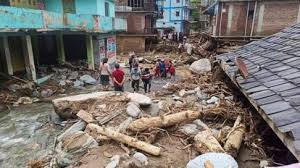Himachal landslide: death toll climbs to 80 amid ongoing rescue ops; damages estimated at Rs 692 crore so far

Shimla, July 8, 2025 — Himachal Pradesh is facing one of its worst monsoon disasters in recent years. Torrential rains, flash floods, and landslides have killed at least 80 people since June 20. Rescue teams are racing against time to find dozens who remain missing.
The State Disaster Management Authority (SDMA) confirmed that 52 people died in rain-related incidents. These include landslides, flash floods, and cloudbursts. The remaining 28 deaths happened due to road accidents, electrocution, and other hazards linked to heavy rainfall.
Mandi and Kangra Suffer the Most
Mandi district reported the highest number of rain-related deaths, with 17 fatalities. Kangra followed with 11. Other affected districts include Shimla, Kullu, Bilaspur, and Lahaul-Spiti. Officials say around 30 people are still missing, mainly in Mandi’s remote regions.
Rescue operations are underway across all impacted districts. Teams from the Army, NDRF, SDRF, ITBP, and police are working with local volunteers. Sniffer dogs and drones are helping locate people trapped under debris or washed away by floods.
Damages Estimated at ₹692 Crore
The state government has estimated losses of over ₹692 crore. This includes the destruction of public infrastructure, private homes, vehicles, and livestock.
Key statistics reported:
- 320 homes destroyed
- 38 homes partially damaged
- 14 bridges collapsed
- 225 roads blocked or damaged
- 241 water schemes broken
- 31 vehicles washed away
- 163 transformers ruined
- 10,254 livestock and poultry dead
A major ₹121 crore water project in Seraj and Balichowki also sustained heavy damage after a cloudburst.
Government and Community Respond
Chief Minister Sukhvinder Singh Sukhu visited flood-hit regions to oversee relief operations. The state government has distributed over 1,500 ration kits. It also released ₹12.44 lakh in relief funds. Regions like Jhanjeli and Thunag each received ₹5 lakh in emergency aid.
Despite the support, rescue teams face many obstacles. Continuous rain, broken roads, and steep terrain slow down the search. A state official said, “We are doing our best, but the scale of destruction is massive.”
Political Leaders Visit Affected Areas
Leaders across party lines visited affected communities. Deputy CM Mukesh Agnihotri, BJP MP Kangana Ranaut, former CM Jai Ram Thakur, and BJP state chief Rajiv Bindal met with survivors.
Religious institutions also stepped in. Local temples and gurdwaras offered shelter and meals to displaced families.
Monsoon Havoc in Numbers
Since the monsoon began on June 20, the state has witnessed:
- 23 flash floods
- 19 cloudbursts
- 16 major landslides
The India Meteorological Department (IMD) has issued yellow alerts for many districts. Officials have urged people to avoid steep slopes, riverbanks, and risky roads.
Infrastructure Collapses Across the State
The rains disrupted roads, power lines, and water supplies. In Mandi alone, 176 roads remain blocked. Traffic across National Highway 3 and many link roads is at a standstill.
Electric poles and transformers lie scattered across streets. In many villages, power and water have been out for days. Repair teams are working to restore services, but damage to internal roads slows them down.
Environmental Warnings Ignored?
Environmental experts believe unchecked construction has worsened the crisis. Many blame deforestation and construction on steep slopes for increasing landslide risk.
“Concrete has replaced forests, and riverbeds are full of illegal structures,” said a geologist at Himachal University. “Nature warned us, but we didn’t listen.”
Experts also warn that climate change is leading to more intense rainfall events, causing more flash floods and landslides.
What’s Next for Himachal Pradesh?
As the monsoon continues, the top priority is rescuing those still missing. Authorities are also focused on restoring road links, power, and water. Relief teams are helping families who lost homes, cattle, or crops.
The Himachal government has asked the central government for financial support. State officials say rebuilding will take months. A new disaster management plan is in the works, with better early warning systems and safer construction guidelines expected soon.
Final Word
Himachal Pradesh’s current crisis reflects a growing trend of climate-driven disasters. Rescue workers, officials, and volunteers continue their tireless efforts. But the disaster highlights a bigger question: Can development and ecology ever go hand in hand in the fragile Himalayas?






